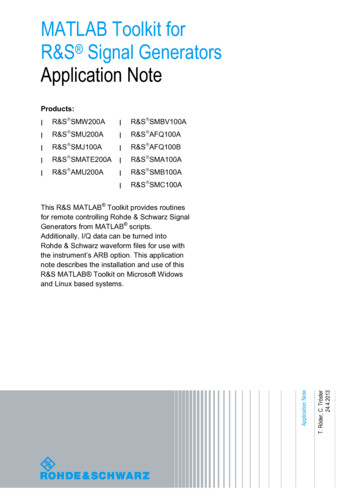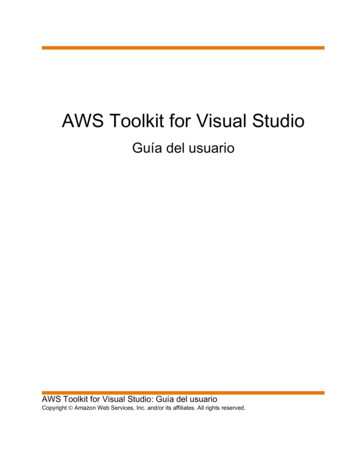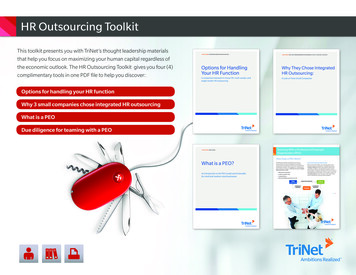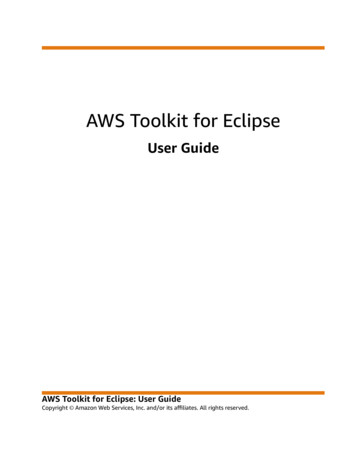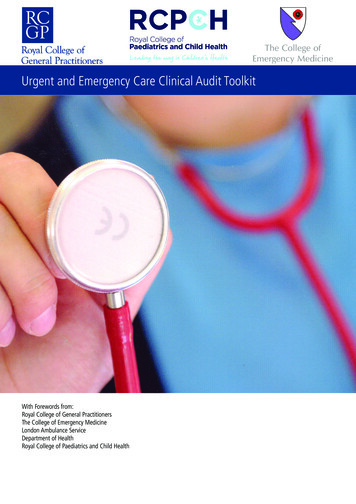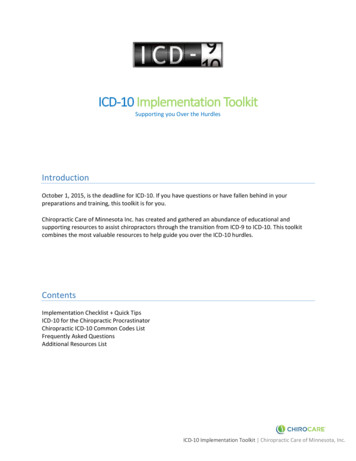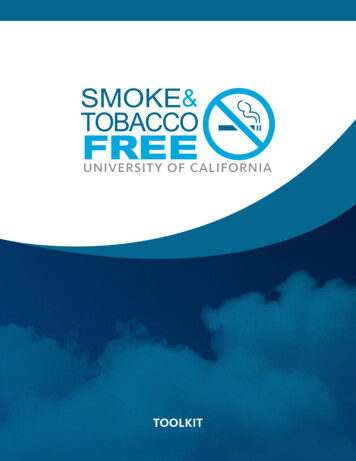
Transcription
TOOLKIT
Introductionmanaging its fiscal and business operations andsupporting the academic and research missions acrossits campuses, labs and medical centers. President JanetNapolitano assumed responsibilities in September 2013as the 20th president of the University of California; shedirectly oversees the 10 campus chancellors and thedirector of the Lawrence Berkeley National Lab.The University of California (UC) system has been 100%smoke and tobacco-free since January 2014. The decisionfor the UC system to go smoke/tobacco-free began ata systemwide occupational wellness forum in August2011. This forum brought together representativesfrom all UC campus and medical centers specializingin Occupational Health, Recreation, Risk Management,and Wellness. A key outcome from this meeting was arecommendation that the UC system become tobaccofree to create healthy work, learning and patient careenvironments. This recommendation resulted in thecreation of the “Smoke-free Policy Proposal” documentin October 2011, which was presented to (now former)President Mark Yudof and the Council of Chancellors byDr. Jack Stobo, Senior Vice President of Health Sciencesand Services, and Grace Crickette, (now former) ChiefRisk Officer at UC Office of the President (UCOP).Each year in the United States, cigarette smoking causesan estimated 480,000 deaths, including approximately41,000 deaths from secondhand smoke exposure amongnonsmoking adults (1). Smoke-free policies protectnonsmokers from secondhand smoke exposure, reducethe social acceptability of smoking, help in preventingyouth and young adult smoking initiation, and increasesmokers’ efforts to quit smoking (1,2). Given that 99% ofadult cigarette smokers first start smoking before age 26years and many smokers transition to regular, daily useduring young adulthood (2), colleges and universitiesrepresent an important venue for protecting students,faculty, staff members, and guests from secondhandsmoke exposure through tobacco control policies (3).College smoke and tobacco-free policies are a rapidlyemerging trend. As of November 2017, at least 2,082U.S. college and university campuses were smoke-free.Among these campuses, 1,743 (83.7%) were tobaccofree; 1,658 (79.6%) specifically prohibited e-cigaretteuse; and 854 (41.0%) specifically prohibited hookahsmoking (4). A large body of evidence has demonstratedthat smoke-free policies reduce heart attacks, (5)asthma, (6) emphysema exacerbations (7) and smokingprevalence.(8) College smoke and tobacco-free policieslead to lower smoking rates across the campus andchange social norms surrounding tobacco use.(9)BackgroundThe University of California (UC) opened its doors in1869 with just 10 faculty members and 40 students.Today, the University of California system includes 10campuses, 5 medical centers, 3 national laboratorieswith a student population of 238,700 students and198,300 employees.In January 2012, President Yudof issued a mandate to allUC Chancellors, “As a national leader in healthcare andenvironmental practices, the University of California isready to demonstrate leadership in reducing tobacco useThe UC Office of the President (UCOP) is thesystemwide headquarters of the University of California,UC SMOKE& TOBACCO-FREE TOOLKIT1
and exposure to secondhand smoke by creating a smokefree environment on all of our campuses.” Individualcampuses and other UC owned facilities could designtheir own implementation process, but Yudof’s letterspecified the requirements of the policies: (1) besmoke-free (defined as no smoking, no use of smokelesstobacco products, and no use of unregulated nicotinedevices) in all indoor and outdoor spaces; (2) apply to allUC property; (3) prohibit advertising and sales oftobacco products; (4) be enforced primarily througheducation and emphasizing smoking cessation.each campus, but included key areas such as Cessation,Communications, Education/Training, Enforcement,and Student Engagement. UCOP provided guidanceand expertise through the Center of Excellence. Thesystemwide Task Force met via phone on a monthly basisto share best practices, leverage resources, and discusschallenges.The Systemwide PolicyIn January 2014, UC implemented a systemwide smokeand tobacco-free (S/TF) policy for all UC campuses, labsand medical centers to improve the health and safetyof all students, staff, faculty, patients and visitors. Thepolicy prohibits the use of cigarettes, e-cigarettes, cigars,snuff, snus, water pipes, pipes, hookahs, chew, and othernon-combustible tobacco products.To further develop and implement the policies, asystemwide Smoke/Tobacco-Free Task Force was formedunder the leadership of UC Office of the President(UCOP) Office of Risk Services. The Task Force consistedof individuals who were charged as Chair/Co-Chairs ofthe Steering Committee at their campus locations bytheir Chancellor. The Task Force was a diverse groupof representatives from Faculty, Occupational HealthPhysicians/MD’s, Environmental Health & Sciences,Wellness, Health Promotion/Student Affairs, ExecutiveVice Chancellor/Provost, and Office of the Chancellor.The policy: (1) defines “smoke-free” beyond cigarettesmoking to include the use of smokeless tobaccoproducts and unregulated nicotine devices (e.g.,e-cigarettes) in all indoor and outdoor spaces; (2) appliesto all UC owned or leased property, including parkinglots, sidewalks, and residential spaces; (3) prohibitsadvertising and sales of tobacco products; (4) has reliedon education and smoking cessation outreach as theprimary enforcement strategy.In February 2013,representatives fromthe individual campustobacco-free task forcesbegan monthlysystemwide meetingsto discuss progress andchallenges thecampuses and otherfacilities (such as theLawrence BerkeleyNational Laboratory)were facing. Thesemeetings were chaired by the Center of Excellence forWellness and Health Promotion, a UCOP systemwideresource created to provide leadership to promote ahealthier workplace through wellness-focused initiativessuch as the Smoke/Tobacco Free Policy and other healthpromotion initiatives.The UC Smoke/Tobacco-Free Policy is a systemwidePresidential policy approved by the President andrecommended by the Policy Steering Committee. Thesystemwide policy provide the minimum requirementsthat need to be included in all local policies, however, UClocations can implement more restrictive policies withAdministration approval.Policy ImplementationThe following is a general outline of both thesystemwide and local tobacco policy implementationat UC campus locations and medical centers along withdescriptions of key priority areas. Chancellors at eachcampus charged a Steering Committee led by a chair orco-chairs to develop the policy and implementation plan.Each campus formed their own committees andsubcommittees to develop and implement the policyno later than January 1, 2014. Subcommittees varied atUC SMOKE& TOBACCO-FREE TOOLKIT2
The Steering Committee was charged with:in addition to traditional ceremonial activities ofrecognized cultural and/or religious groups (uponwritten request and approval) Responsibility and authority for coordinatingimplementation of the local Smoke/Tobacco-FreePolicy.University of California – Smoke and Tobacco Free Environment PolicySmoke and Tobacco Free Environment Oversight of the implementation plan and thesubcommittees.Responsible Officer: Chief Risk OfficerResponsible Office: RK – Risk / EH&SIssuance Date: 5/31/2018Effective Date: 5/31/2018Last Review Date: 3/16/2018UC students, staff, academic appointees, visitors,Scope: patients, contractors, and volunteers. This Policy doesnot apply to Lawrence Berkeley National Laboratory.Contact: Ken SmithTitle: EH&S Executive DirectorEmail: Ken.Smith@ucop.eduPhone: (510) 987-0170 Identification and procurement of funding as wellas management of funding for the implementationplan (communications, signage, cessation programs/resources, training, and ongoing costs).For a copy of the UC systemwidepolicy and links to each UC locationpolicy, see pages 53-58.TABLE OF CONTENTSI.II.III.IV.V.VI.VII.VIII.I.POLICY SUMMARY . 1DEFINITIONS . 2POLICY STATEMENT . 2COMPLIANCE/RESPONSIBILITIES . 3REQUIRED PROCEDURES . 4RELATED INFORMATION . 5FREQUENTLY ASKED QUESTIONS . 5REVISION HISTORY . 6POLICY SUMMARYAs a public institution of higher education with units that research and treat the effects ofsmoking, tobacco and marijuana use, the University of California (UC) recognizes itsresponsibility to exercise leadership in the promotion of a healthy, smoke/tobacco-freeenvironment for all students, academic appointees, staff, and visitors. This PresidentialPolicy and associated procedures are intended to provide a healthier, safer, and moreproductive work and learning environment for the entire UC community.1 of 6Subcommittees were created, and each was taskedwith identifying a lead as well as the group’s members.Subcommittees created an implementation planthat was shared with the Steering Committee. Eachsubcommittee lead was responsible for communicatingupdates/progress/challenges at Steering Committeemeetings. An effort was made to ensure subcommitteesincluded non-smokers, ex-smokers, and current tobaccousers as well as stakeholders in various relevant areasuch as grounds keeping, police/security, patientrelations, wellness, EH&S, etc.Summary of Priority Areas(Subcommittees)Cessation Support ServicesCreate a Comprehensive Cessation BenefitRemoving cost barriers by providing full coverage(100 percent) for tobacco cessation medications andcounseling increases utilization as well as long-termquitting success. The most effective tobacco cessationbenefits cover proven treatment options with no out-ofpocket expense.The subcommittees were charged to: Engage the University community in dialoguesregarding smoke/tobacco-free implementation.UC health plans provide comprehensive cessationservices for faculty and staff. All UC-sponsored nonMedicare medical plans provide prescription and overthe-counter tobacco cessation products at no additionalcost when prescribed by a physician, along with optionalbehavioral modification programs to help employeesquit smoking. Develop the implementation plan on the focus areaof the subcommittee and make recommendations tothe Steering Committee.Priority areas for subcommittees related to policyimplementation were identified as follows: Cessation Support ServicesUC students have access to cessation services throughthe UC Student Health Insurance Plan (SHIP), whichincludes physician visits at the campus Student HealthCenters, prescription and over the counter (OTC)medications, and behavior modification programs tohelp students quit. Communications/Marketing Education/Training Enforcement/Compliance Environment Policy Management, Assessment, and EvaluationIn June 2018, the systemwide policy was updated andstrengthened to align with the Americans for NonSmokers’ Rights model policy and criteria: includingincorporation of marijuana into policy language,inclusion of electronic nicotine delivery systems,and removal of exemptions other than for researchUC SMOKE& TOBACCO-FREE TOOLKITIn addition, several UC campuses and health systemsoffer free in-person 1:1 and group cessation counseling,free Nicotine Replacement Therapy (NRT), and referralsto the California Smokers’ Helpline (1-800-NOBUTTS) operated by UC San Diego and available to allCalifornians.3
Policy is promoted through flyers, posters, banners,stickers, postcards, door signs, etc.UC LIVING WELLTobacco CessationResourcesUC is committed to providing our faculty and staff with atobacco-free environment. To support this policy and helpthose who want to quit smoking, the university offerscomprehensive smoking cessation resources for facultyand staff.All UC-sponsored non-Medicaremedical plans provide prescriptionand over-the-counter tobaccocessation products at noadditional cost when prescribedby a physician, along with optionalbehavioral modification programsto help you quit smoking.The additional resources here areavailable through your medical plan –usually at no cost to you.11 This is a summary only; limitations, exclusions, exceptionsand other qualifiers may apply. Call the plan or see the plan’swebsite for plan booklets and detailed benefit information.SMOKING CESSATIONBENEFITSSMOKING CESSATION BENEFITSSERVICES OFFEREDOffice Visits withStudent Health CliniciansTo discuss smoking cessation with a clinician call your student health center or go toyour campus student health center website to make an appointment.Prescription DrugsCovered prescription drugs are available at student health centers or at OptumRxnetwork pharmacies to assist with smoking cessation.Living Free ProgramUC SHIP members receive a discount off Anthem’s Living Free program at Anthem.com/ca when you sign on as a member.Additional Campus Programsand InformationVisit ucop.edu/ucship. Go to your campus student health center webpage forsmoking cesssation information and support. Counselors and health educators areavailable to answer your questions and provide support.Core, UC Care, UC Health Savings PlanHealth Net Blue & GoldKaiser Permanente Healthmedia Breathe (kp.org/quitsmoking) Telephone-based coaching (Northern California:866-251-4514; Southern California: 866-862-4295) On-site counseling, classes and programs (contactyour local Kaiser medical center) A systemwide smoke/tobacco-free website is usedto communicate the policy along with associatedresources and announcements. Each location alsohas their own smoke/tobacco-free website.Living Free is an online training and support program that provides: 12 lessons on how to quit smoking Coaching and interactive support A library of information on nicotine addiction and how to kick the habitHealthy Lifestyles Tobacco-Free Program(anthem.com/ca) Health Promotion Program for tobacco cessation(Healthnet.com/uc) Quit for Life telephone-based coaching(866-784-8454) Policy language is inserted into all agreements andcontracts.As a national leader in healthcare and environmental practices, UC is committed to providing our studentswith a tobacco-free environment. The information below explains the benefits and programs studentscan access through the UC Student Health Insurance Plan (UC SHIP). Copayments may apply — pleaseconsult your plan brochure or Summary of Benefits for more information. Visit www.ucop.edu/ucship formore information about UC SHIP.HELPFUL LINKS California Smokers Helpline, 1-800-NO-BUTTS www.webmd.com/smoking-cessation www.SmokeFree.gov/Western Health AdvantagePrograms available through your medical groupCommunications were developed to inform adjacentbusinesses, neighbors, and the community aboutthe smoke/tobacco-free policy. Communicating withmembers of the surrounding community is key tominimizing the impact the policy may have outsidecampus boundaries. This is because many tobacco usersleave campus to smoke on outside property potentiallycreating additional noise, litter, and traffic.UCSHIP/02.21.17For a list of cessation support services available through theUC medical plans and UC SHIP, see pages 18-19.Lesson LearnedIt is important to provide and communicateabout a variety of cessation support services (oncampus, off campus, in-person, phone/online, etc.)prior to policy implementation so that the campuscommunity has time to prepare. In addition,cessation support services should be continuouslypromoted and easily accessible for when tobaccousers are ready to quit.For a comprehensive list of places to promote the policy, seepage 20.Lesson LearnedCommunicate early and often about the policy.Communications should continue to be gearedtowards specific audiences with investmentsmade in temporary and permanent signage. Acompelling image and branding increases visibilityfor the policy.CommunicationsCommunication is critical to the effective transition andon-going sustainability of a smoke/tobacco-free campus.Each UC campus developed plans for communicating thepolicy with all students, faculty, staff, and visitors prior tothe implementation of the policy. Communication plansincluded the initial announcement of the policy alongwith extensive communications occurring from the timethe policy announcement was made by UCOP to theeffective date and beyond. All policy communicationswere positive, respectful, and tied to tobacco cessationresources, with an emphasis placed on UC’s commitmentto health and safety.Education and TrainingEducation and Training is critical to informing thecampus community about the policy, enforcementprocess, and cessation services.Trainings can be provided for: Educating the campus community about the smoke/tobacco-free policy and cessation resources.Examples of ways the policy is communicated: Policy language is included in prospective student/staff/faculty materials, websites, orientation,employment materials, visitor information, etc. Encouraging managers and supervisors about thepolicy, including communication, enforcement,cessation, and addressing policy violators. Signage is located throughout campus tocommunicate that all University facilities, buildings,and grounds are smoke/tobacco-free. Encouraging students to communicate the policy topeers.UC SMOKE& TOBACCO-FREE TOOLKIT Educating employees about the dangers ofsecondhand and third hand smoke.4
UC created the “AIR” approach usedfor training the campus communityon how to Approach, Inform, andRefer policy violators to cessationservices. In addition, a series ofvideos were developed to providereal life scenarios and examples ofways to approach individuals violating the smoke/tobacco-free policy.Through the authority provided in CaliforniaGovernment Code 7597.1, the governing body of theUniversity of California has the authority to establishpolicy for smoking and tobacco use as well as setenforcement standards at local campuses. Each campushas the authority to establish fines for violations ofthis policy, but such fines must not exceed 100.00per violation. To date, no UC campus is enforcingwith citations and using the educational approach forenforcement.Smoke & Tobacco-Free Supervisor Talking PointsAs a supervisor, you may encounter faculty, student employees and staff who violate the Smoke/Tobacco-Free policybecause they are not aware of it, or are not willing to comply with it. As a system-wide policy, it applies to all members ofthe University community. Below are suggestions you can use when you need to have a conversation with someoneabout their compliance with the policy.1. Briefly state what you want to discuss. Open your conversation with non-accusatory, neutral phrases. I’d like to talk to you about the Smoke/Tobacco Free policy on campus and what we can do to ensure thateveryone follows it.2. Describe specifically what you observed. If your employee was reported by someone else, be specificand objective about what was reported. Avoid attacking the individual. Focus on the behavior. Be briefand to the point. Yesterday you were seen smoking behind the building.3. State the impact of the action. Focus on a common goal or purpose, and state the consequences. Again,focus on the behavior, not the person. It’s important that we respect our campus policies. I realize that this may be hard, but we have alwayshad policies regulating smoking on campus and we must work together to ensure we can all comply withthe policy.4. Ask them to respond. Summarize their key points. Remember, acknowledging their frustration, anger,etc. does not indicate agreement, but that you are trying to understand their point of view. It offerssupport, but does not indicate that you agree with them or with their actions. It sounds like this is a frustrating time for you. It sounds like you are angry about the policy and don’t agree with it. It sounds like you don’t think that the policy is fair.5. Focus the discussion on solutions. Ask for their input on ways they can comply with the policy. Offerempathy, but focus on solutions. Offer support and resources if appropriate. Let’s talk about what you’ll do the next time you feel the need to smoke during working hours. What ideasdo you have on how you can manage the situation? What can I do to help/support you?6. Follow-up with the employee. Focus on offering your support. Let’s meet again in two weeks to discuss how you’re doing. It’s important to me that you succeed in thisplan, so please let me know anytime between now and when we meet if you’re having difficulties.This guide is not intended to address all situations. If you need additional assistance in addressing noncompliance with thepolicy please feel free to contact the Labor Relations office.For examples of training materials, please see pages 22-44.For UC specific enforcement and compliance strategies, seepages 53-58.Lesson LearnedFor accountability, incorporate the Smoke/Tobacco-Free Policy into existing employee,manager, and supervisor trainings. Offer trainingsonline and in-person.Enforcement and ComplianceThe University of California Office of the Presidentrecommends that campuses use an educationalapproach to enforce the smoke/tobacco-free policy. Theeducational method of enforcement includes awarenessmaterials, cards for distribution that include informationon the smoke/tobacco-free policy and cessationresources, scripts for talking to a smoker, talking pointsfor managers/supervisors, training, and support tools.Lessons LearnedConsider multiple methods of compliance andenforcement as there is no single solution. Socialnorm change takes time (and patience) to keepat it and learn from what other organizations aredoing!All members of the UC Community are expected toadhere to the policy and to the required proceduresdescribed in the local campus policy. UC’s primaryenforcement strategy is through education andawareness. Various strategies have been developed andimplemented at UC locations and highlighted on pages8-12 in this guide.EnvironmentAll UC owned and leased facilities, buildings, grounds,and athletic properties, are smoke/tobacco-free. Inorder to ensure a smoke/tobacco-free environment, UClocations created temporary and permanent signagelocated on buildings, doors, windows, A-frame/windstands, etc.Noncompliance with the policy is handled in accordancewith Personnel Policies for Staff Members pertaining todisciplinary actions. It is also handled with the AcademicPersonnel Manual concerning the Faculty Code ofConduct and administration of discipline and Universitylocation-specific policies for students through StudentConduct office.UC SMOKE& TOBACCO-FREE TOOLKITAll ashcans/ash trays were removed prior to the effective5
date of the policy. Some campuses repurposed ashcansand used them for artwork.10 Key Steps for UC Smoke/Tobacco-Free PolicyImplementationTo view images of UC location signage, see page 52.Lessons Learned1.Identify and form a Steering Committeeresponsible for policy development andimplementation. Include representationfrom management, service workers, faculty,students, former smokers, and non-smokers.2. Utilize existing campus data to understandthe issue of smoking and exposure tosecondhand smoke on campus. Obtain surveydata regarding use of all forms of tobaccoand nicotine by students, faculty, and staff toestablish a baseline for the campus.3. Develop an implementation and budget planbefore reviewing them with management.4. Develop the policy and associated proceduresprior to allowing the campus the opportunityto comment on the policy.5. Implement any necessary environmentalchanges. Remove ashtrays from companypremises and post “tobacco-free” signage.6. Assess what current cessation servicesare offered on campus and in the nearbycommunity as well as provide multiplemethods for support.7. Provide trainings and educational sessionsabout tobacco use, how to approach policyviolators, cessation support services available,etc.8. Assess and utilize all communicationchannels to promote the policy.9. Explore methods to enforce the policythrough education, awareness, and active/punitive methods.10. Evaluate the outcomes of the policy. Developand/or utilize measurement or assessmenttools to monitor progress towards policyimplementation. Track and report results,best practices, and lessons learned.Even though there will be an increase in litter,removing ashcans sends the message that tobaccouse is not allowed. Prepare for signs to be stolen,damaged, and worn out. Make sure to allow forextra signs and sign holders in your budget.Local PolicyA UC systemwide policy was created as a frameworkfor each campus and health system. Local policies andprocedures can be more stringent than systemwidepolicy, which serves as a minimum requirement.The UC Systemwide Task Force utilized severalmethods for assessing the impact of the policy and itsimplementation. Data was collected through survey,tobacco waste/litter (i.e. butt counts), data reports, etc.to provide quality improvement and identify key areasof focus for post implementation. A number of issuesare documented including: policy non-compliance;smoking debris; environmental impact; attitude shifts;implementation problems; geographic challenges; costsof implementation; efficacy of conflict resolution.All UC locations ensured the workforce had anopportunity to review and understand the recommendedpolicy before implementation. These locations alsoconfirmed that the workforce followed local proceduresfor policy review and comments.For a copy of the UC systemwide policy, see pages 53-58and links to each UC location policy, see page 21.A great benefit of working within a large universitysystem is the ability to network and share strategiesand resources. Within the UC System there were severalcommon steps that campuses took towards successfulpolicy implementation.UC SMOKE& TOBACCO-FREE TOOLKIT6
UC Smoke/Tobacco-Free PolicyImplementation Evaluation - Fordetails about UC’s policyimplementation and evaluation, see“Evaluation of the Implementationof the University of California’sTobacco-Free Policy” by AmandaFallin, Maria Roditis, and Stan Glantz from March 2015.The Executive Summary is on page 59.February 2017 to showcase UC’s policy experiencerelated to promotion, cessation, education andcompliance. It was also created to be used as abenchmark and measurement tool. The dashboard is aguide for action planning at each UC location and will beupdated on an annual basis to track progress. See pages62-67 for full Dashboard.Evaluation of the Implementation of theUniversity of California Tobacco-free PolicyAmanda Fallin, PhD, RN Maria Roditis, PhD, MPH StantonGlantz, PhDCenter for Tobacco Control Research and EducationUniversity of California San Francisco, San Francisco, CA, 941431390March 3, 2015In 2017, UC systemwide task force members beganworking with the California Youth Advocacy Network(CYAN) to strengthen policy compliance efforts on all 15sites within the system (10 educational campuses, fivemedical campuses). CYAN is a non-profit organizationfunded by the California Tobacco Control Program tosupport colleges and universities with the adoption,implementation, and enforcement of smoke/tobaccofree policies. Collectively, CYAN and UC campusesidentified four strategies for strengthening compliance.These strategies include: Ambassador Program,Signage, Online Compliance Training, and PolicyPromotion and Integration. Each of these strategiesutilize lessons learned from past policy complianceactivities implemented at UC campuses. During the2017-2018 academic year, each UC campus began usingor expanding existing compliance activities to furtheridentify which intervention works best for reducingtobacco use on campus. Results of these activities willbe available in June 2019.ComplianceSince the successful implementation of the policyin January 2014, UC continues to explore variouscompliance and enforcement strategies that combineeducation and active enforcement through existingpersonnel procedures. Unfortunately, even with strongersmoke/tobacco-free policies, secondhand smoke maydrift into buildings, cigarette litter may be a persistentproblem on campus, and compliance with policies maybe minimal.California Government Code 7597.1 gives the governingbody of the University of California the authority toestablish policies for smoking and tobacco use and setenforcement standards at local campuses. Each campushas the authority to establish fines for violations ofthis policy, but such fines must not exceed 100.00 perviolation. To date, none of the UC campuses or healthsystem locations are issuing fines due to limitationsspecific to how this code is written as well as limitedresources and support. Therefore, UC’s are pursuingvarious educational and active enforcement approaches.Post-policy compliance activities UC campuses havebeen using since policy implementation in 2014 includethe following: Continued educational activities such as distributionof reminder cards, campus events, and social media. Environmental scans to assess policy compliancethrough the cigarette butt litter, signage, andsmokers in “hot spots”.In ord
College smoke and tobacco-free policies are a rapidly emerging trend. As of November 2017, at least 2,082 U.S. college and university campuses were smoke-free. use; and 854 (41.0%) specifically prohibited hookah smoking (4). A large body of evidence has demonstrated that smoke-free policies reduce heart attacks, (5)


